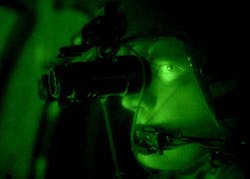Officials of the Army Contracting Command at Aberdeen Proving Ground, Md., have issued a request for information (RFI W909MY14QMAVE) for the Multispectral Augmented Visually Enhanced Reality Imaging Capability (MAVERIC) program.
This market survey seeks to identify companies or universities with the night-vision know-how to develop multispectral sensor prototype hardware that could aid in the overall MAVERIC program goals.
U.S. military researchers are pursuing the MAVERIC program in partnership with the United Kingdom Ministry of Defence (MOD). The MAVERIC RFI was issued on behalf of the Army's Research, Development and Engineering Command (RDECOM) Communications-Electronics Research, Development and Engineering Center (CERDEC) Night Vision and Electronic Sensors Directorate (NVESD) at Fort Belvoir, Va.
Related: DRS to develop enabling technologies for special-ops multispectral night-vision goggles
Specific thrusts of the MAVERIC program revolve around low-light imaging sensors; uncooled focal plane arrays; cooled focal plane arrays; micro displays and head-mounted displays; and augmented reality.
For the low-light imaging sensor, researchers want to evaluate high-dynamic-range solid-state focal plane array sensors with resolutions of at least 1,280 by 1,024 pixels that operate in the visible-light and near-infrared bands, in the near-infrared and shortwave infrared bands, or in the visible-light, near-infrared, and shortwave infrared bands.
The goal is to integrate a small, low-power alternative to image-intensification tubes into a handheld vision system for daylight and nighttime surveillance.
Related: 3 companies to develop multispectral camera for helmets and weapon sights for DARPA
Army researchers are looking for new focal plane designs, materials, and manufacturing processes for enhanced low-light sensitivity with substantial improvements over today's night-vision technologies in the areas of noise reduction, photon conversion efficiency, and in-pixel digitization with parallel data interfaces.
Uncooled focal plane array work should demonstrate a large-format, small-pixel, uncooled longwave infrared (LWIR) focal plane arrays with 1280-by-1024-pixel resolution uncooled with a pixel pitch of 12 microns or smaller.
Cooled focal plane array work should demonstrate a high-performance, large-format focal plane arrays with at least 640-by-480-pixel resolution using the latest material and cooling technologies.
Related: Navy picks Creative Microsystems to design next-generation night-vision technology
Micro displays and head-mounted display work should demonstrate micro displays and display modules suitable for low-profile, high-resolution mounted virtual imaging applications. For this, researchers want displays with low power consumption and improvements in contrast, luminance, and color gamut.
Augmented reality work should integrate an Android Tactical Assault Kit (ATAK) into a head-up display or overlaid onto a sensor system, with real-time presentation of blue force tracking, cursor-on-target, navigation data, beyond line-of-sight points of interest, and other enhanced situational awareness information.
Ultimately, researchers want to develop a next generation long-range handheld device that will demonstrate long-range targeting in all battlefield conditions.
Related: Raytheon wins another contract for Multi-Spectral Targeting Systems for Navy helicopters
Companies interested should email 15-page white papers on one or more MAVERIC program topics to the Army's Michelle Hodges at [email protected] no later than 14 July 2014. Put MAVERIC Program RFI in the subject line.
For questions or concerns phone Michelle Hodges at 703-704-0846. More information is online at https://www.fbo.gov/notices/31a8558d25dc6afd001382a01e483979.



